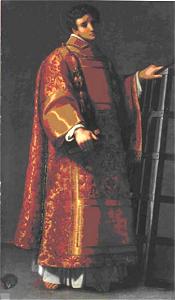| Saint Lawrence
SN 130, oil on wood panel, c1608
Francesco Curradi
Italian, 1570-1661
From "The Pages"
ARTIST:
Francesco Curradi was born in Florence in 1570, and died there in 1661 at the age of 91.
He has been generally overlooked by historians, partly due to the lack of 17th c.
biographical information on his long career. A student of the Florentine late-Mannerist
painter Giovanni Battista Naldini (1537-1591), Curradi was a prolific artist. He usually
painted religious subjects, only occasionally including a secular work. Most of his
pictures remain in Italy; about half-a-dozen are in N. America. |
|
 |
SUBJECT:
This is a full-length Baroque portrait of the patron saint of Florence, St Lawrence. Born
in Spain, he was appointed archdeacon by Pope Sixtus II. When the pontiff was seized by
the Romans and condemned to death, he commanded Lawrence to distribute the church’s
property to the poor. Furious at being bilked of the fortune, the Roman prefect tortured
Lawrence by binding him to a gridiron and burning him alive. During his grilling, Lawrence
is purported to have said “Turn me over and cook the other side.” He died on
August 10, 258 AD.
PAINTING:
Full length, barefoot St Lawrence appears as a beardless youth holding a book in his right
hand, with the gridiron (emblem of his martyrdom) in his left. He is dressed in a
deacon’s dalmatic, made of sumptuous fabric. Calm and serene, the whole image is one
of intense religious devotion. St Lawrence’s face appears melancholy, nostalgic. The
profound piety of the picture accords with the strong religious convictions of the artist.
Stylistically it fits somewhere between late Mannerist and early Baroque painting.
Initially trained as a Mannerist, Curradi soon began to imbue his work with the new spirit
of the Counter Reformation. Sacred images were to be more lifelike, to appear capable of
achieving direct communication of spiritual convictions. His Mannerist origins still
affect anatomy, though…the head seems way too small for the body. Altho’, to be
fair, often such stiff, heavy robes often seemed to be wearing the man rather than vice
versa!
This painting spent several years in storage before its debut under new and definitive
attribution. John Ringling purchased it in 1927 from the Holford Collection as a work by
Domenichino (Domenico Zampieri,1581-1641), one of the great Bolognese artists. That
attribution was discarded, as well as one to Gregorio Pagani (1558-1605).
There is another painting, virtually identical, in the chapel of S Maria Maddalena
de’ Pazzi in Florence, which is actually signed by Curradi and dated 1608. Only minor
details differ, and finally in 1987 ours was returned to the oeuvre of Curradi by Mina
Gregori.
ringlingdocents.org
|